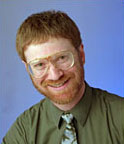 |
→ December 2004 Contents → Column
|
Common Cents
December 2004
|
 |
|
Specializing in a niche subject is one solution to shrinking opportunities for editorial photographers (See August Common Cents.) But specializing in a single medium may limit your future. Anybody who is waiting for stabilization in technology is going to be disappointed. The learning curve is going to be constant for anybody who wants to stay in the business from here on. If you think of yourself strictly as a "still photographer," you may find that your skills are falling behind marketplace realities. As video resolution increases, it will become trivial to use digital frame grabs in place of dedicated still images. Savvy photographers who add video to their bag of tricks will find that the same composition skills that they use for still images work just as well in video shot composition. Former Time magazine photographer - and publisher of The Digital Journalist - Dirck Halstead espouses the "Platypus" concept of photojournalism. Platypi are photographers who use whatever medium they deem appropriate to tell a story, often shooting both stills and video on a single assignment. Still shooter Scott Highton has not only helped pioneer Virtual Reality (VR) photography, he's shared his expertise in a wealth of educational material on his Virtual Reality Photography Web site. Just some of the skills that clients are already looking for:
Traditional still images will always have a place in the media, but only a very few elite photographers will be able to build a career out of making them. The mainstream belongs to those who are not afraid to grow by adopting new skills. The Good
None this month.
The Bad
The Associated Press for lowering its member contributor fees again. This time in South Dakota. What could possibly justify cutting a $7.50 fee to five bucks? The AP's paper clip budget for South Dakota has got to be more than that.
The Ugly
None this month. Please let me know of any particularly good, bad or ugly dealings that you have had with clients recently. I will use the client's name, but I won't use your name if you don't want me to. Anonymous submissions will not be considered. Please include contact information for yourself and for the client. Leftovers
Perhaps the contributors have more business savvy than 24/7 planned for. I choose to think so and be thankful for that. Connections: NPPA Independent Photographers Toolkit Advertising Photographers of America Resource page Common Cents Column On The Cost of Doing Business Editorial Photographers Cost of Doing Business Calculator
© Mark Loundy
|
|
Back to December 2004 Contents
|
|
